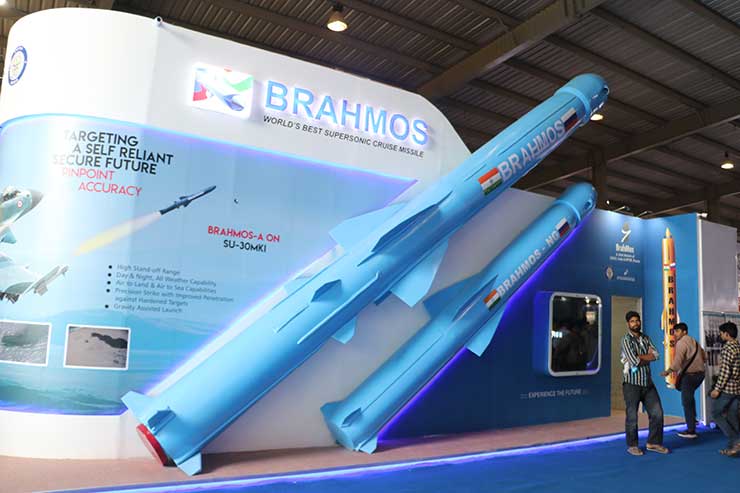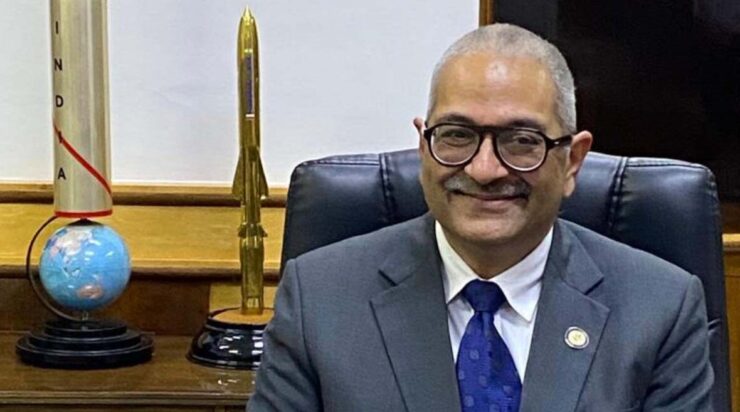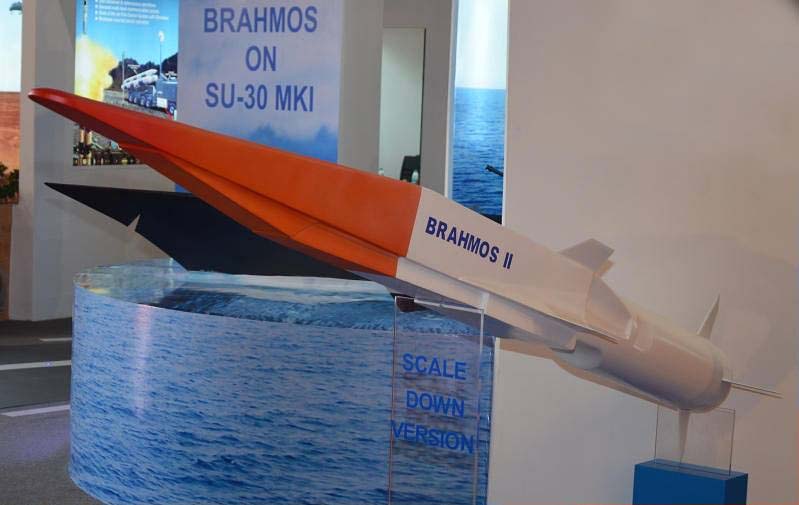
Named after the Brahmaputra and Moskva rivers, the BRAHMOS missile system has been one of India’s most successful weapons programmes. A joint-venture between the DRDO and Russia’s NPO Mashinostroyeniya, who together formed BrahMos Aerospace, the missile has continually evolved to meet the challenges of modern warfare. Unlike ballistic missiles, which are propelled for only half of their journey and follow a pre-defined parabolic trajectory, the BRAHMOS exhibits a range of trajectories, such as high, high-low, low, surface-skim and steep dive. Plus, moments before hitting the target, the BRAHMOS makes an S manoeuvre, further increasing the difficulty of tracking, engaging and intercepting the missile.
BRAHMOS II represents the latest leap in this evolution, introducing capabilities that promise to redefine the dynamics of missile technology. The missile traces its roots to 2007 when the former President of India, APJ Abdul Kalam, initiated the delivery of the BRAHMOS missile system to the Army. During this process, he proposed the development of a Mark-II version, specifically a hypersonic cruise missile.
Subsequently, in September 2009, India and Russia signed a memorandum of understanding, marking a crucial milestone. This 2009 agreement played a pivotal role in defining the ultimate parameters for the new iteration of the BrahMos missile, officially named BRAHMOS II. The MoU from 2009 outlined specific specifications for BRAHMOS II, which included the following:
- BRAHMOS II will be based on a hypersonic scramjet technology.
- The prime purpose of such a weapon is to target deeply buried enemy nuclear bunkers and heavily protected locations.
- All three defence services will utilise this weapon.
BRAHMOS II represents the latest leap in this evolution, introducing capabilities that promise to redefine the dynamics of missile technology. The missile traces its roots to 2007 when the former President of India, APJ Abdul Kalam, initiated the delivery of the BRAHMOS missile system to the Army
The defining characteristic of BRAHMOS II is its hypersonic speed, which means it can travel at speeds exceeding five times the speed of sound (6,115 kilometres per hour) or greater. This level of velocity provides several advantages, including reduced reaction time for adversaries. The missile’s ability to travel at such high speeds makes it significantly more challenging for enemy defences to detect and intercept. Plus, the tremendous kinetic force means enhanced destructive power – targets like warships are often cut in half.
Precision is another key aspect of BRAHMOS II. The missile is designed to hit its target with unparalleled accuracy, making it a formidable weapon for both strategic and tactical scenarios. The combination of hypersonic speed and precision ensures that the missile can deliver its payload with unprecedented efficiency.
Hypersonic missiles fall into two distinct categories. In what is known as a boost-glide weapon, the hypersonic vehicle is first boosted on a ballistic trajectory, using a conventional rocket. It may cover considerable distance as it flies to high altitude, then falls back to Earth, gaining speed and finally, at some relatively low altitude, pulling into unpowered, aerodynamic, horizontal flight. After that, it glides at hypersonic speed toward its final destination.
Hypersonic cruise missiles, on the other hand, typically are launched to high speed using a small rocket, and then, after dropping the rocket, are powered by a supersonic combustion ramjet or scramjet for hypersonic flight.
Development efforts
Currently, Russia is the only operator of this class of weapons, and this was demonstrated in the ongoing war with Ukraine when in early March of this year the Russian military initiated its most significant aerial assault of the conflict. This attack featured a diverse array of weapons, with particular attention drawn to the deployment of six air-launched hypersonic missiles. Known as Kinzhal – meaning dagger in Russian – these missiles boast an impressive speed of Mach 10 and carry a substantial payload of 480 kg. While hypersonic weapons had been employed earlier in the conflict, this marked the first instance of six being utilised simultaneously in a single wave.
The defining characteristic of BRAHMOS II is its hypersonic speed, which means it can travel at speeds exceeding five times the speed of sound (6,115 kilometres per hour) or greater. This level of velocity provides several advantages, including reduced reaction time for adversaries
For nearly a decade, India has been pushing Russia toward developing the hypersonic missile on an ambitious schedule. In 2014, BrahMos Aerospace announced that India had designs for a new engine. The main challenge is to find materials resistant to very high temperatures. Although the hull of this missile is made of composite materials, hypersonic speeds subject it to heavy friction and high temperatures. To resolve this issue, a coating made of special alloys is being developed.
In 2017, Sudhir Kumar Mishra, CEO and MD, said BrahMos Aerospace is trying to increase the missile’s speed from Mach 3 to Mach 5. “With this, we will enter into the hypersonic regime,’’ he said.
In April 2023, National Security Advisor Ajit Doval and his Russian counterpart Nikolai Patrushev discussed the potential joint development of the hypersonic version of the BRAHMOS missile. Atul Rane, CEO of BrahMos Aerospace, acknowledged the possibility of BRAHMOS II sharing certain features with Russia’s Tsirkon missile. He highlighted the successful testing of Russia’s Tsirkon hypersonic anti-ship cruise missile developed by NPO Mashinostroeniya, emphasising the collaborative effort in designing the “technology bricks” for hypersonic missiles by both Russia and India.

The Tzirkon, a scramjet-powered anti-ship hypersonic cruise missile, exhibits remarkable capabilities, capable of achieving Mach 9 speeds, ascending to an altitude of 28 km (92,000 feet) and covering distances of up to 1,500 km. While designed for launch from ships and submarines, there are reports of an ongoing development of a land-based version in Russia.
Konstantin Biryulin, the Deputy General Director of Korporatzia Takteecheskoye Raketnoeye Vooryzhenuye, the primary holding company overseeing missile manufacturing, including the Russian collaborator of BRAHMOS, NPO Mashinostroeniya, has indicated Russia’s readiness to share hypersonic technologies with friendly nations. Biryulin envisions the completion of the BRAHMOS II by 2028, marking a significant milestone in the collaborative efforts between BrahMos Aerospace and its Russian partners.
For nearly a decade, India has been pushing Russia toward developing the hypersonic missile on an ambitious schedule. In 2014, BrahMos Aerospace announced that India had designs for a new engine. The main challenge is to find materials resistant to very high temperatures
Despite the programme’s technological expertise and collaborative initiatives, the journey towards its realisation is laden with challenges and uncertainties. The intricacies of international cooperation, combined with technical and logistical obstacles, have led to setbacks in the programme’s progress. Analysts predict that due to these factors, the BRAHMOS II might not materialise for several more years, with projections stretching into the next decade. Some estimates even extend as far as 2030 or beyond before the missile receives clearance for full-scale production.
India’s Plan B – Going solo
Simultaneously, India is actively engaged in the Hypersonic Technology Demonstrator Vehicle (HSTDV) program, strategically positioned as a precautionary measure against potential American sanctions affecting India-Russia missile cooperation. Notably, the indigenous HSTDV programme operates with distinct funding and research efforts, separate from those dedicated to BRAHMOS II. This will insulate the project not only from Western sanctions but also from potential disruptions in Russia’s military industrial sector because of the Ukraine War.
Israel has contributed support to the HSTDV programme, engaging in activities such as wind tunnel testing, along with assistance from Cranfield University in the UK. Another undisclosed third country is also participating in the project. Reports suggest that Russia has played a crucial role in providing assistance to the endeavour. India’s primary defence-industrial collaborator is Russia, leveraging its extensive research in hypersonic propulsion.

Scramjet technology serves as a pivotal component in the development of hypersonic weapons. Diverging from conventional subsonic or ramjet engines, a scramjet utilises supersonic compressed air through an inlet force, combining it with hydrogen fuel. This unique mechanism enables the engine to achieve speeds exceeding Mach 5.
According to a report by the New Delhi-based Centre for Air Power Studies, India embarked on scramjet technology testing in 2016, achieving a significant milestone on August 28, 2016, when ISRO successfully tested two domestically developed scramjet engines.
Despite the programme’s technological expertise and collaborative initiatives, the journey towards its realisation is laden with challenges and uncertainties. The intricacies of international cooperation, combined with technical and logistical obstacles, have led to setbacks in the programme’s progress
In pursuit of advancing scramjet capabilities, India conducted tests in 2019 and 2020 on an indigenously developed Hypersonic Technology Demonstrator Vehicle (HSTDV), which was powered by a scramjet engine. Although the 2019 test was deemed unsuccessful, the 2020 test proved to be a success. During the 2020 test, the scramjet-powered HSTDV sustained flight for approximately 22-23 seconds, attaining a remarkable Mach 6 speed. Notably, for the 2020 HSTDV test, the solid motor of the Agni-I ballistic missile served as the launch vehicle.
The 2020 HSTDV test played a crucial role in validating various essential elements of a hypersonic weapon, marking significant progress in India’s hypersonic ambitions. Specifically, the test confirmed the success of the following critical technologies:
- Aerodynamic layout for hypersonic manoeuvres.
- Use of scramjet propulsion for ignition and constant combustion at the hypersonic stream.
- Thermo-structural enactment of high-temperature materials
- Separation mechanism at hypersonic velocities.
In 2023, India carried out the third HSTDV trial, the outcome of which remains undisclosed. However, according to media reports, the initial launch and take-off was successful. But there are question marks on the subsequent performance of the scramjet engines of the HSTDV, for which the data has to be analysed in detail.
India’s hypersonic ambitions are on the right path, and the recent developments in this domain are a testament to it. In 2023, the BrahMos Aerospace Corporation stated, “If we want a hypersonic missile, we will take only eight years to develop it after the approval from the government
On February 5, 2024, it was reported that the Indian Institute of Technology Kanpur successfully established and tested India’s first Hypervelocity Expansion Tunnel Test Facility. The ground-breaking establishment and test have been lauded as a major step for India to further enhance its aerospace research and defence capabilities.
Endgame
The development of the scramjet is claimed to be indigenous, though scepticism arises due to uncertainties surrounding India’s research and development capabilities in the power plant domain. Notably, there is a lack of domestically produced engines even for programs such as the Light Combat Aircraft.
Still, India’s hypersonic ambitions are on the right path, and the recent developments in this domain are a testament to it. In 2023, the BrahMos Aerospace Corporation stated, “If we want a hypersonic missile, we will take only eight years to develop it after the approval from the government.”
In the face of a more assertive China, which has already showcased its hypersonic capabilities in recent military exercises near Taiwan, and the potential spread of such technologies to its vassal Pakistan, it is essential that India pursue the development of a hypersonic successor to the supersonic BRAHMOS.
– The writer is a globally cited defence analyst. His work has been published by leading think tanks, and quoted extensively in books on diplomacy, counter terrorism, warfare and economic development. The views expressed are of the writer and do not necessarily reflect the views of Raksha Anirveda















